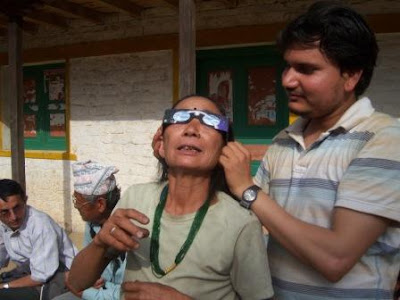














Full report coming soon...................
Three trinkets of NASO set off yesterday to Terhathum for Chhatedhunga . They are Mr. Sudeep Neupane (Founder VP) Mr. Suresh Bhattarai (Founder Secretory) and Mr. Rijendra Thapa(Founder Member). This programme of NASO is a part of the global celebration of GAM. NASO set this exploration as Chhatedhunga was campared to Stone Henge of England. So, this exploration is to indentify whether Chhatedhunga is really a stone henge or not.Duirng the exploration,there will programmes like talks, Solar observation and Star parties in different parts of Jhapa, Panchthar, Tehrathum and Sunsari districts of Nepal.
 Photo:Star Gazers in Kathmandu pointing to the thundering area on the eve of new year 2067!
Photo:Star Gazers in Kathmandu pointing to the thundering area on the eve of new year 2067! Photo: Star Gazers looking at the evening sky through the binaculars on new year's eve on April 14,2010.
Photo: Star Gazers looking at the evening sky through the binaculars on new year's eve on April 14,2010.
 Photo:NASO Executive members ready during the completion of Solar Observation with the telescope. From left: Mr. Rijendra Thapa ( founder member),Mr.Sudeep Neupane (founder vice president),Er. Rishi Shah (founder president),Mr. Suresh Bhattarai ( founder Secretary) and Mr. Riwaj Pokhrel ( founder Member)
Photo:NASO Executive members ready during the completion of Solar Observation with the telescope. From left: Mr. Rijendra Thapa ( founder member),Mr.Sudeep Neupane (founder vice president),Er. Rishi Shah (founder president),Mr. Suresh Bhattarai ( founder Secretary) and Mr. Riwaj Pokhrel ( founder Member) Photo: 8 inch Dobsonian from Sky Watcher used for solar observation. This telescope was bought with the help of TWAAN in 2009 for better outreach in Nepal.
Photo: 8 inch Dobsonian from Sky Watcher used for solar observation. This telescope was bought with the help of TWAAN in 2009 for better outreach in Nepal.  Photo: Mr. Rijendra Thapa, Founder member and NPoC of SGAG for Nepal, Mr. Sudeep Neupane, Founder Vice President of NASO and co-ordinator of CALP-NEpal and Mr. Riwaj Pokhrel, Founder member of NASO and NC of AWB for Nepal wearing solar eclipse glasses for solar observation.
Photo: Mr. Rijendra Thapa, Founder member and NPoC of SGAG for Nepal, Mr. Sudeep Neupane, Founder Vice President of NASO and co-ordinator of CALP-NEpal and Mr. Riwaj Pokhrel, Founder member of NASO and NC of AWB for Nepal wearing solar eclipse glasses for solar observation. Photo: Official Poster for SUNDAY issued by Global Astronomy Month (GAM) 2010.
Photo: Official Poster for SUNDAY issued by Global Astronomy Month (GAM) 2010. Photo: Poster designed by Azhy Ch. Hasan, president of President of Amateur Astronomers Association of Kurdistan / Iraq.
Photo: Poster designed by Azhy Ch. Hasan, president of President of Amateur Astronomers Association of Kurdistan / Iraq. Photo: One of the participant looking at the SUN through Telescope during the event.
Photo: One of the participant looking at the SUN through Telescope during the event. Photo: One of the female participant asking about the event and why we celebrate GAM2010 and SUN Day in Nepal to president Er. Rishi Shah. Er. Shah is also an academician of Nepal Academy of Science and Technology(NAST), Nepal.
Photo: One of the female participant asking about the event and why we celebrate GAM2010 and SUN Day in Nepal to president Er. Rishi Shah. Er. Shah is also an academician of Nepal Academy of Science and Technology(NAST), Nepal. Photo: A Banner for the 30 Nights of Star Peace for April 4-6 with the flags of participants countries Nepal,India,Pakistan and Sri Lanka.
Photo: A Banner for the 30 Nights of Star Peace for April 4-6 with the flags of participants countries Nepal,India,Pakistan and Sri Lanka.  Photo: Venus and Mercury closed toe ach other in the western horizon of Delhi,captured by C.B. Devgan,S.P.A.C.E. India on April 6,2010.
Photo: Venus and Mercury closed toe ach other in the western horizon of Delhi,captured by C.B. Devgan,S.P.A.C.E. India on April 6,2010. Photo: S.P.A.C.E captured -8 Iridium Flare as seen in the sky above Delhi on April 6,2010.
Photo: S.P.A.C.E captured -8 Iridium Flare as seen in the sky above Delhi on April 6,2010.

